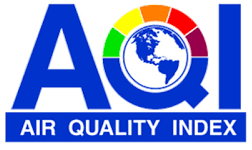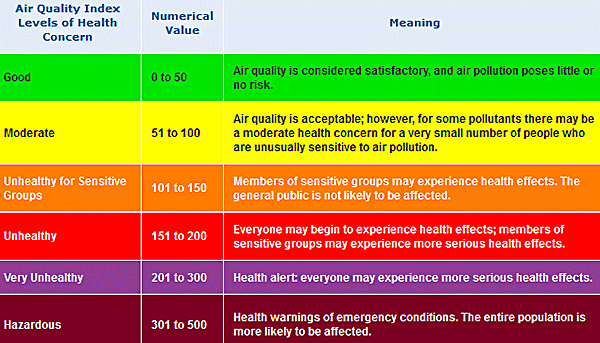 The Air Quality Index (AQI) is a national air standard rating system developed by the U.S. Environmental Protection Agency. The AQI is used statewide to provide the public, on a daily basis, with an analysis of air pollution levels and possible related health risks.
The Air Quality Index (AQI) is a national air standard rating system developed by the U.S. Environmental Protection Agency. The AQI is used statewide to provide the public, on a daily basis, with an analysis of air pollution levels and possible related health risks.
Generally, an index scale of 0 to 500 is used to assess the quality of air, and these numbers are synchronized with a corresponding color and descriptor word such as: Good, Moderate, Unhealthy for Sensitive Groups, Unhealthy, and Very Unhealthy.
To protect public health, the EPA has set an AQI value of 100 to correspond to the National Ambient Air Quality Standard (NAAQS) for the following criteria pollutants: Ozone (O3), Sulfur Dioxide (SO2), Carbon Monoxide (CO), Particulate Matter 10 (PM10), Particulate Matter 2.5 (PM2.5), and Nitrogen Dioxide (NO2).
The index value of 100 is associated with the numerical level of the short-term standard (i.e., averaging time of 24-hours or less) for each pollutant. The AQI for a reporting region equates to the highest rating recorded for any pollutant within that region. Therefore, the larger the AQI value, the greater level of air pollution present, and the greater expectation of potential health concerns. However, this system only addresses air pollution in terms of acute health effects over time periods of 24 hours or less and does not provide an indication of chronic pollution exposure over months or years.

AQI Meaning
This figure shows how the recorded concentrations correspond to the AQI values, descriptors and health advisories. Each day the AQI values are available for many of Georgia EPD’s sites. The AQI figures are reported to news media and EPA’s AIRNOW for applicable pollutants in all metropolitan areas of the United States with populations exceeding 350,000.

Pollutant Index Value
On days when two or more pollutants exceed the standard (have AQI values greater than 100) in one metropolitan area, the air quality index from the pollutant with the highest concentration is used for that reading. The pollutant responsible for the highest index value is called the ‘critical’ pollutant.
Groups within the general population can be more sensitive to higher concentrations of different pollutants.
More Resources
View EPA page: AQI Basics
Air Quality Index - A guide to Air Quality and Your Health
What does the EPA say about the AQI?